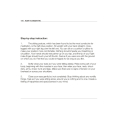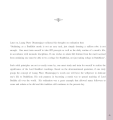one leg : ค้นหาหนังสือธรรมะ หน้า 3 / 4
หน้าหนังสือทั้งหมด

141
Understanding the Five Precepts
Do you know what the Five Precepts are?
1. One shall not kill.
2. One shall not steal.
3. One shall not commit adultery.
4. One shall not lie.
5. One shall not consume intoxicants.
I will explain to y
This text introduces the Five Precepts of Buddhism, emphasizing the importance of ethical behavior. The narrative begins with a question from a senior monk about love and life, illustrating that all b

48
Seven Kinds of Offerings to the Sangha
" There are seven kinds of offerings made to the Sangha, Ānanda.
One gives a gift to a Sangha of both [bhikkhus and bhikkhunīs] headed by the Buddha; this is the first kind of offering made to the San
This text outlines the seven kinds of offerings one can make to the Sangha, including gifts to the collective body of monks and nuns, and individual offerings specifying bhikkhus or bhikkhunīs. The fi

66
The Virtue of Approving in Velāma Sutta
66
The Virtue of Approving
7. Velāma Sutta
"Now, householder, if the thought should occur to you,
'Perhaps it was someone else who at that time was
Velāma the brahman, who gave that gift, t
In the Velāma Sutta, the householder is reminded that true merit comes not from the quantity or grandeur of gifts, but from the character and realization of those who receive them. The teaching emphas

82
Hiri-Ottapa: Understanding Shame and Fear of Wrongdoing
Hiri-ottapa – Shame and Fear of Wrongdoing
Hiri and ottapa are Pali words, meaning ‘shame of wrongdoing’ (hiri) and ‘fearful of the consequence of wrongdoing’ (ottapa). One who has hiri-ottapa is one
Hiri and Ottapa are pivotal concepts in Buddhism, representing the shame of wrongdoing and the fear of its consequences. Together, they foster a good moral conscience. Individuals devoid of these trai

148
How to Meditate: A Step-by-Step Guide
144 HOW TO MEDITATE
Step-by-step instruction:
1. The sitting posture, which has been found to be the most conducive for meditation, is the half-lotus position. Sit upright with your back straight, cr
Meditation is an essential practice for achieving inner peace and relaxation. This guide provides a step-by-step approach to meditating effectively. Begin by adopting the half-lotus position, where yo

147
Meditation Technique: The Seven Bases of the Mind
Suzanne Jeffrey
Step-By-Step introductions for the meditation technique:
The Seven Bases of the Mind.
1. The sitting posture, which has been found to be the most conducive for meditation, is the hal
This guide introduces the Seven Bases of the Mind meditation technique, emphasizing the importance of proper posture, relaxation, and focus. Begin by adopting a comfortable half-lotus position or sitt

88
Step by Step Instructions for Meditation Technique
Step by Step Instructions for the Meditation Technique
1. The sitting posture, which has been found to be the most conducive for meditation, is the half-lotus position. Sit upright with your back and
This guide provides detailed step-by-step instructions for a meditation technique, focusing on the half-lotus sitting posture for comfort and alignment. It emphasizes the importance of relaxation thro

93
Unlocking Meditation Potential
By deepening our meditation until our mind comes to a standstill we can unlock the potential and unused ability within.
We maintain a balance of mindfulness and happiness for ourselves bringing conte
Through deep meditation, we can tap into our untapped abilities and maintain a balance of mindfulness and happiness, enriching our lives in ways other techniques can’t. This guide introduces the effec

120
Meditation: The Half-Lotus Posture Guide
Step-by-step instructions
1. The sitting posture, which has been found to be the most conducive for meditation, is the half-lotus position. Sit upright with your back straight, cross-legged with your
This guide provides step-by-step instructions on adopting the half-lotus position for meditation. Start by sitting upright with a comfortable cushion and cross-legged stance, ensuring proper breathing

24
Dhamma for Laypersons: Cultivating Good Habits
A person who has the Dhamma for Laypersons
(Gharavas-dhamma) must display four regular habits:
1. Habit of Responsibility - Whatever the task at hand,
he must do it to the best of his ability, in term
บุคคลที่มีธรรมสำหรับอุบาสกอุบาสิกาต้องแสดงถึงนิสัยประจำสี่ประการ ได้แก่ นิสัยความรับผิดชอบ, การฝึกฝนและพัฒนาตนเอง, ความอดทน, และการเสียสละและการให้ นิสัยเหล่านี้ช่วยทำให้กลายเป็นผู้นำครอบครัวที่ดี การ

150
The Significance of Ordination in Thai Culture
I have seen parents make funeral arrangements for their
children, grandparents for their grandchildren. It should not
be this way, and I certainly did not want this to happen to me.
But since life is
This text reflects on the challenges of prioritizing personal commitments while facing family health issues and the cultural importance of ordination in Thai society. It highlights how ordination is s

154
Confronting Life's Inherent Sufferings
"Even though we may dislike difficulties and welcome
happiness, there is no way to avoid suffering in our lives
because life is a mixture of suffering and happiness. Instead,
we should prepare for the
This text discusses the duality of suffering and happiness in life. It emphasizes the natural forms of suffering such as aging, sickness, and death that everyone faces. Many people distract themselves

155
Understanding Death and the Purpose of Life
do not know when we are going to die. We must sooner or
later be separated from all loved ones and treasured things.
How can people think about death?
1. Thinking about death with the false view: Thin
This text explores the dual perspectives on death: one as a mere inevitability leading to despair, and the other as a motivator for a purposeful life. It emphasizes the cultivation of good deeds and m

196
พระพุทธเจ้า - ต้นแบบแห่งปัญญา
Chapter 44
The Lord Buddha - The Role Model of Wisdom
Having experienced much in life, we clearly understand
the meaning of vicissitudes. No one gains merely fortune or
misfortunate throughout life; l
ในบทนี้ได้กล่าวถึงพระพุทธเจ้าในฐานะต้นแบบแห่งปัญญา โดยเน้นถึงความจริงในชีวิตที่มีทั้งความสุขและความเศร้า รวมถึงการรับมือกับความรู้สึกเหล่านั้นอย่างมีสติ ไม่ควรปล่อยให้ความสุขกลายเป็นปัญหาสำหรับผู้อื่น

45
Reflections on Buddhist Ordination by Luang Phaw Dhammajayo
Later on, Luang Phaw Dhammajayo reflected his thoughts on ordination that:
“Ordaining as a Buddhist monk is not an easy task, just simply donning a saffron robe is not enough. One must train oneself t
Luang Phaw Dhammajayo reflects that ordaining as a monk requires more than just wearing the robe; it involves training to take on the 227 precepts and adhering to monk's disciplines. His commitment to

24
Dhamma for Laypersons and the Four Levels of Beauty
A person who has the Dhamma for Laypersons
(Gharāvās-dhamma) must display four regular habits:
1. Habit of Responsibility – Whatever the task at hand, he must do it to the best of his ability, in t
A person who follows the Dhamma for Laypersons exhibits four habits: responsibility, self-training, endurance, and sacrifice. These traits ensure self-reliance and leadership within families. In marri

196
The Lord Buddha - The Role Model of Wisdom
Chapter 44
The Lord Buddha - The Role Model of Wisdom
Having experienced much in life, we clearly understand the meaning of vicissitudes. No one gains merely fortune or misfortunate throughout life
In Chapter 44, we learn from the Lord Buddha about the duality of life, encompassing both joy and sorrow. It emphasizes the importance of moderation in happiness and the courage to overcome sorrow. Th

6
Udaya Sutta - Breaking the Cycle
The Victure of Aousiving
6
1. Udaya Sutta¹
Breaking the Cycle
The origin is Śāvatthi. The Blessed One putting on robes in the morning and taking bowl and robes approached the Brahmin Udaya’s house.
This text recounts the story of the Blessed One visiting Brahmin Udaya's house three times in a single day for alms, receiving rice each time. Udaya's annoyance at the repeated visits brings forth a d

18
Kaladana Sutta: Seasonable Gifts
4. Kaladana Sutta:
Seasonable Gifts
"There are these five seasonable gifts.
Which five?
One gives to a newcomer.
One gives to one going away.
One gives to one who is ill.
One gives in time
Kaladana Sutta outlines five important seasonable gifts: giving to a newcomer, someone departing, an ill person, in times of famine, and offering first fruits to virtuous individuals. These gifts emph

44
The Virtue of Abstaining: Dakhinābhibhānga Sutta
44
The Virtue of Abstaining
6. Dakhinābhibhānga Sutta
One gives a gift to one outside [the Dispensation]
who is free from lust for sensual pleasures;30
this is the eleventh kind of personal offering.
In the Dakhinābhibhānga Sutta, the text discusses the significance of personal offerings in different contexts. It compares giving gifts to various recipients, such as virtuous and immoral individuals
